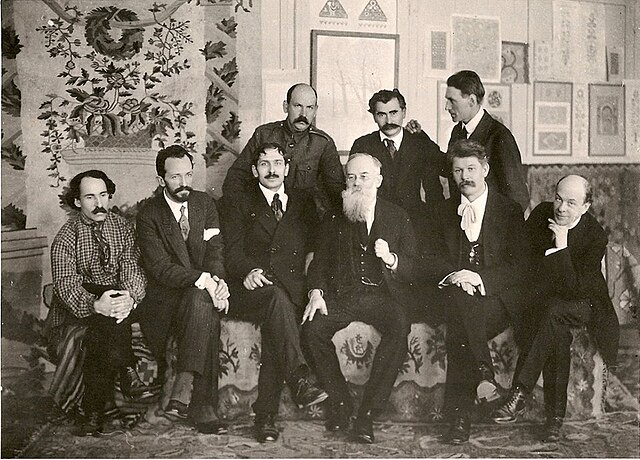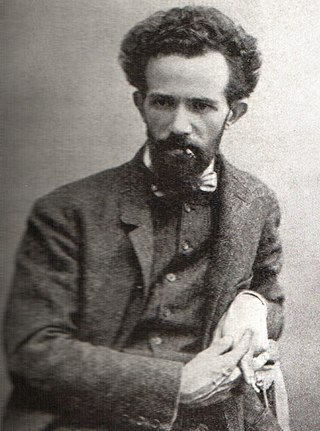Top Qs
Timeline
Chat
Perspective
Oleksandr Murashko
Ukrainian painter (1875–1919) From Wikipedia, the free encyclopedia
Remove ads
Oleksandr Oleksandrovych Murashko (Ukrainian: Олександр Олександрович Мурашко; September 7 [O.S. August 26] 1875 – June 14, 1919) was a prominent Ukrainian artist, widely known for his unusually expressive paintings.
You can help expand this article with text translated from the corresponding article in Ukrainian. (June 2016) Click [show] for important translation instructions.
|

Remove ads
Life and career
Summarize
Perspective
Murashko was born in Kyiv. His stepfather, Oleksandr Ivanovych Murashko, had an icon-painting workshop and worked on the interior of St Volodymyr's Cathedral.[1][2] The future painter's uncle Mykola Murashko was the founder of Kyiv Painting School, which produced a number of notable painters including Mykhailo Zhuk, Ivan Yizhakevych, Petro Kholodnyi, Valentin Serov, Kazimir Malevich and Vassili Kandinsky.[3]
In 1894, with recommendations from several prominent artists, he entered the Imperial Academy of Arts in St Petersburg. In 1896, he became a student of Ilya Repin;[1] he is one of those depicted in Yelena Makovskaya-Luksch's group portrait, Repin's Students.[4] In 1901, he travelled abroad, visiting Germany, where he studied with Anton Ažbe in Munich,[4] Italy, and France, where he was greatly influenced.[1]
Murashko became a successful artist; he has been called "the most important Ukrainian artist of the turn of the century".[5] His painting Carousel won the gold medal at the Munich Exposition in 1909, and he exhibited in Venice, Rome, Amsterdam, Berlin, Cologne, and Düsseldorf.[1]
From 1909 to 1912, Murashko taught at the Kyiv Art School. In 1913, he opened his own studio in the Ginsburg skyscraper,[1][6] where many young Jewish artists were trained, including Mark Epstein.[7][8] He had a great influence on Kazimir Malevich.[9]

He was a patriotic Ukrainian, one of the adherents of the "Young Muse" movement which was started in 1906 by Modernists who drew on developments elsewhere in Europe to make Ukrainian art more progressive.[10] He founded the Association of Kyiv Artists in 1916[11] and the following year co-founded the Ukrainian State Academy of Arts.[1]
In 1909, Murashko married Marguerite Kruger, a notary's daughter.[1] In 1910, after his father's death, he bought a small house in the Kyiv suburb of Lukyanivka. He was taken away from the house, apparently by a street gang, and shot from behind on June 14, 1919. His funeral was well attended and he was buried in the Lukyanivsky Cemetery.[1]
Remove ads
Works
Summarize
Perspective
Originally a realist in the style of the Peredvizhniki,[9] Murashko later painted in a "refined", Impressionist style influenced by his time in Munich and Paris.[12][13][14] His Modernism in turn influenced later Ukrainian artists in the Socialist Realist period.[15] His works are less often narrative and unusually expressive for Ukrainian paintings of the time.[5]
Selected list of paintings

- Portrait of Nikolai Petrov, 1897–98
- Portrait of Helen Murashko, 1898–99
- Portrait of Olga Nesterov, 1900
- The Funeral of the Chieftain, 1900[16]
- Parisian. At the Cafe, 1902–03
- Girl in a Red Hat, 1902–03
- A Girl with a Dog. Portrait of T. Yazevoyi, 1903–04
- Portrait of Professor Adrian Prahova, 1904
- Winter, 1905
- At the Embroidery Frame. Portrait of Helena Prahova, 1905
- Carousel, 1906
- In the Stern. Portrait of George Murashko, 1906
- Sunspots. Portrait of George Murashko, 1908
- Portrait of Marguerite Murashko, 1909
- The Annunciation, 1909
- Portrait of Ludmilla Kuksin, 1910
- Portrait of Vera Dytyatinoyi, 1910
- Portrait of Vera Yepanchin, 1910
- By the Pond. Portrait of Marguerite Murashko, 1913
- Peasant Family, 1914
- Washerwoman, 1914
- Portrait of an Old Woman, 1916
- Woman with Flowers, 1918
- Self Portrait, 1918
- Paintings by Oleksandr Murashko
- Portrait of Mykola Petrov
- Portrait of Ludmilla Kuksin (1910)
- Winter (1905)
- Washerwoman (1914)
- By the Pond. Portrait of Marguerite Murashko (1913)
Remove ads
References
Further reading
External links
Wikiwand - on
Seamless Wikipedia browsing. On steroids.
Remove ads





